Abstract
This study is the first in the literature to systematically assess the environmental impacts of magnesium oxychloride cement (MOC) samples, which are regarded as a more eco-friendly construction material than Portland cement. The environmental impacts of MOC samples prepared with various molar ratios of MgO/MgCl2∙6H2O and sources of reactive magnesia were obtained via a life cycle assessment (LCA) approach (from cradle to grave), and the obtained outcomes were further compared with the counterparts associated with the preparation of Portland cement (PC) samples. Meanwhile, a sensitivity analysis in terms of shipping reactive magnesia from China to Europe was performed. Results indicated that the preparation of MOC samples with higher molar ratios led to more severe overall environmental impacts and greater CO2 sequestration potentials due to the difference of energies required for the production of MgO and MgCl2∙6H2O as well as their various CO2 binding capacities, whereas in terms of CO2 intensities, the molar ratios in MOC samples should be carefully selected depending on the strength requirements of the applications. Furthermore, various allocation procedures and MgO production processes will greatly influence the final outcomes, and allocation by mass is more recommended. Meanwhile, the environmental impacts associated with the transportation of reactive magnesia from China to Europe can be ignored. Finally, it can be concluded that MOC concrete is no longer a type of ‘low-carbon’ binder in comparison with PC concrete in terms of CO2 emissions, and in view of the single scores and mixing triangles for weighing, MOC concrete can only be identified as a type of more sustainable binder than PC concrete when the main component MgO in MOC samples is obtained through the dry process route rather than the wet process route.
1. Introduction
Magnesium oxychloride (MOC) cement, which was invented not long after Portland cement (PC), is categorized as a nonhydraulic binder that forms from the reaction between magnesia (MgO) and a magnesium chloride (MgCl2) solution [,]. In MOC samples, a MgO–MgCl2–H2O ternary system is formed along with phase-5 (5Mg(OH)2∙MgCl2∙8H2O) and phase-3 (3Mg(OH)2∙MgCl2∙8H2O) crystals. These crystals are stable at temperatures <100 °C, which contributes to the rapid hardening and the very high early strength, reaching 120 MPa to 140 MPa depending on the formulations []. MOC is regarded as a sustainable binder [], and has received great research interest due to its superior properties such as fire and abrasion resistance [], making it suitable for industrial applications in fire protection, flooring and grinding wheels [,,].
Reactive MgO, which is the key component in MOC, has been widely investigated in a series of studies in the area of construction [,,,,,], and can be obtained through the following two main approaches: (i) calcination of magnesia-based minerals (e.g., magnesite, dolomite or serpentine); and (ii) synthesis from brine/seawater []. The majority of MgO on the market is obtained via the calcination of natural earth minerals such as magnesite (MgCO3) with a calcination temperature of 700–1000 °C. However, the acquired MgO presents low purities and inferior reactivities since impurities are unavoidable in the raw materials []. Therefore, in order to obtain MgO with higher purities and reactivities, MgO may be acquired via the chemical synthesis from seawater or magnesium-bearing brine sources, accounting for about 14% of global MgO production annually [], and the synthetic MgO obtained from seawater/brine has also been proven to outperform MgO obtained from the calcination of magnesite with respect to the aforementioned properties [], which was related to the larger specific surface area (SSA) achieved in synthetic MgO [] in comparison with the MgO from calcination. The procedures concerning the production of reactive MgO in industry from seawater/brine involve the following stages: (i) the acquisition of seawater/brine; (ii) the production of a strong alkali base to be used in the precipitation of Mg(OH)2, and (iii) the calcination of Mg(OH)2 []. As a result, the overall input (i.e., raw materials and energies) and output (i.e., emissions) during the production of MgO was mainly related to the production of the base and the calcination of Mg(OH)2 [].
The other key component in MOC, magnesium chloride hexahydrate (MgCl2∙6H2O), is a colourless crystalline material that is present in nature as bischofite, and contains over 70 other elements owing to the presence of impurities []. MgCl2∙6H2O crystals can be prepared by dissolving magnesium-bearing materials such as magnesium oxide, hydroxide, or carbonate in an aqueous hydrochloric acid (HCl) solution []. Therefore, as magnesite is present as a type of natural mineral, the main energy consumptions and emissions associated with the production of MgCl2∙6H2O are derived from the preparation of the HCl solution.
It is reported that the production of MOC resulted in the lowest material usage and environmental burden in contrast to those associated with the preparation of lime-based and magnesium phosphate cement (MPC)-based binders in biocomposites with hemp []. Meanwhile, a series of studies [,] indicated that construction materials were capable of re-absorbing CO2 during their usage phases, which offsets the carbon footprint associated with their production. As expected, magnesium-bearing materials also present CO2 sequestration potential [,,,,], and it was reported that MOC could also sequestrate CO2 after its utilization, and around 20‒40% of the emissions associated with the energy consumptions and the decomposition of raw materials may be re-sequestrated due to the carbonation over a period of 15 years []. There is also a large number of studies focusing on the energy consumption concerning the production of reactive MgO from the calcination of magnesite or its synthesis from seawater/reject brine. For instance, it was indicated that the major challenge in the production of MgO from seawater was its higher energy demand than that consumed by the calcination of magnesite (17 GJ versus 5.9 GJ per tonne of MgO) []. However, the production process can be optimized and the energy demands of MgO production can be greatly reduced by using waste brine [,]. Although there are numerous studies investigating the mechanical performance and microstructure of MOC [,,], and MOC is regarded as a type of eco-friendly binder [,,,], investigations focusing on the environmental impacts of MOC preparation in a life cycle assessment are scarce. Meanwhile, previous studies ignored the value of by-products during the precipitation of Mg(OH)2 such as NaCl; however, the allocation of environmental burdens (i.e., to the by-products) is also of great importance since sometimes a production process may produce more than one end product, and the environmental burdens have to be divided between these two final products in a way that reflects the underlying relationships between them, e.g., allocation by mass or by economic value [].
The goal of this study was first to assess the environmental impacts of MOC samples prepared with various molar ratios of MgO/MgCl2∙6H2O during its production, reflected by various impact categories and key parameters. Meanwhile, the CO2 intensities based on the mechanical performance and CO2 sequestration potential of MOC samples were also discussed, and the sustainability of MOC samples prepared by various sources of reactive MgO was also investigated. Furthermore, the allocation of environmental burdens related to MOC sample preparation was performed at the same time, and the environmental impacts associated with the transportation of reactive magnesia from China to Europe were also assessed; meanwhile, the results were compared with those related to the production of Portland cement (PC) samples.
2. Materials and Methodology
2.1. Materials, Mix Design and Sample Preparation
The Mg(OH)2 and MgCl2∙6H2O with a purity of 98% used in this study were purchased from Magnesia GmbH (Lüneburg, Germany). The MgO was acquired from the calcination of Mg(OH)2 using a furnace operating at a calcination temperature of 650 °C and a ramp rate of 20 °C/min for a duration of 1 h. The MgCl2∙6H2O was placed into deionised water and mixed using a magnetic stirrer until the crystals were fully dissolved. The MgO obtained from the calcination of Mg(OH)2 was used as the main binder for the preparation MOC samples. In this study, 1.0 kg of paste was prepared for each sample using a Hobart Planetary mixer (Peterborough, UK) by combining the MgCl2·6H2O solution and the MgO powders for 5 min. The molar ratios of MgO/MgCl2 were fixed to 3, 5 and 9 separately during MOC sample preparation, with the workability of the paste being maintained by adjusting the water to solid ratios correspondingly, as shown in Table 1. As the MgO used in this study was calcinated within a lab and the production efficiency was quite low, in order to make full use of the MgO obtained, instead of using a 40 × 40 × 160 mm mould, which is suggested by EN 196-1, a mould with a reduced size (20 × 20 × 160 mm) was adopted to save materials (Figure 1). After the completion of the mixing, the paste was moulded into three prismatic samples, compacted by a vibrating table. After casting, the samples were cured in air for seven days at laboratory room temperature with a relative humidity of 60 ± 5% prior to mechanical testing.

Table 1.
The quantity of each component used to produce 1 kg of MOC sample.

Figure 1.
Size of the mould used in this study.
2.2. Methodology
2.2.1. Compressive and Flexural Strength
The strength values were obtained through the bending and compression tests, and the values were used during the calculations of CO2 intensities, with the details shown in Section 3.1.2. The flexural strength was obtained by the three-point bending test, with the broken samples being subjected to the compression test to obtain the unconfined compressive strength. Both two tests were conducted using a 50 kN universal testing machine (Instron 5960, High Wycombe, UK) at a loading rate of 12.7 mm/min. It was reported that there were some conversion coefficients between these two sizes (This study: 20 × 20 × 160 mm vs. 40 × 40 × 160 mm) depending on the proportions of the cement binder or the shape of samples []; however, the strength values in this study were still utilized directly without any normalizations as they were mainly involved in the CO2 intensity calculations, which will not change the final outcomes or the conclusions.
2.2.2. Environmental Assessment
The environmental impacts of MOC paste prepared with three different molar ratios of MgO/MgCl2·6H2O and two sources of reactive MgO were obtained via a life cycle assessment (LCA) according to [], based on a case study in Europe. MOC samples have been widely used in rapid repair due to their relatively fast strength development []; therefore, it is very common to use MOC paste in the construction field. However, in practice, aggregates and supplementary cementitious materials (SCMs) are also widely introduced in PC sample preparation; therefore, for a fair comparison between MOC and PC samples in terms of the environmental impacts, a certain amount of aggregates (aggregate content/solids content ratio = 2.5) and pulverized fly ash (i.e., 30% of total solid content) was also assumed to be incorporated in MOC paste, and the environmental impacts of MOC and PC concrete were compared. A w/s ratio of 0.34 was used in both MOC and PC concrete as 0.18 and 0.22 were not practical for PC concrete preparation. As mentioned before, there are two sources with respect to the acquisition of MgO: (i) calcination of magnesite (the dry process route); and (ii) synthesis from seawater (the wet process route). During the wet process route, there were no inputs or outputs associated with the production of seawater since it is a natural material; meanwhile, it is also abundant globally, leading to almost zero emissions related to the acquisition of seawater, which is also in line with a previous study []. The first step involved in the synthesis of Mg(OH)2 from seawater is the incorporation of the alkali bases []. Secondly, the obtained Mg(OH)2 was then heated to 650 °C in a furnace for 1 h, whereas during the dry process, the magnesite was calcined at a temperature of 800 °C, undergoing the chemical decomposition shown in Equation (1):
MgCO3 → MgO + CO2.
The MgCl2∙6H2O in this study was synthesized via the reaction between the hydrochloric (HCl) and magnesite (MgCO3) [], which is shown in Equation (2):
MgCO3 + 2HCl + 5H2O → MgCl2∙6H2O + CO2.
- Inventories: The inventories of three types of alkali used in this study, i.e., NaOH, CaO and NH4OH, which are the most frequently used bases in terms of Mg(OH)2 precipitation in industry []. In practice, CaO is more commonly used as an alkali base during the precipitation of Mg(OH)2 due to its cheaper price and larger availability than Ca(OH)2; therefore, CaO was selected in this study instead of Ca(OH)2. Meanwhile, the hydrochloric (HCl) and background data were obtained from the Ecoinvent database developed by the Swiss Centre for Life Cycle Inventories [] and the ETH-ESU database, provided by Eidgenössische Technische Hochschule []. The electricity consumption during the calcination of Mg(OH)2 at the temperature of 650 °C for 1 h was recorded using a plug-in electric energy power meter (Floureon, Shenzhen, China). The inventories of MgO production from the calcination of magnesite were acquired from previous studies [,] (Table 2). The inventories of PC were obtained from a number of references [,,,,], the details of which can be found in [] (Table 3). When comparing MOC and PC concrete, the inventories of aggregates and pulverized fly ash were from Ecoinvent database and [] (Table 4). The quantity of each component used to produce 1 kg of MOC and PC concrete is shown in Table 5.
 Table 2. Inventory for the production of 1 tonne of MgO [,].
Table 2. Inventory for the production of 1 tonne of MgO [,]. Table 3. Inventory for the production of 1 tonne of Portland cement in Europe [,,,,].
Table 3. Inventory for the production of 1 tonne of Portland cement in Europe [,,,,]. Table 4. Inventory for the production of 1 tonne of PFA in Europe [].
Table 4. Inventory for the production of 1 tonne of PFA in Europe []. Table 5. The quantity of each component used to produce 1 kg of PC and MOC (molar ratio: 9) concrete.
Table 5. The quantity of each component used to produce 1 kg of PC and MOC (molar ratio: 9) concrete. - Goal, functional unit and scope: This goal of this study was to perform a comparative assessment of the environmental burdens posed by the preparation of MOC paste prepared using three different molar ratios of MgO/MgCl2∙6H2O, where NaOH was used as the alkali base during the synthesis of MgO, then a comparative environmental assessment of MOC paste, in which different alkali bases were used including CaO, NaOH and NH4OH. Finally, the environmental impacts of MOC concrete prepared with two sources of reactive MgO from the wet (i.e., synthesis from seawater) and dry process routes (i.e., calcination of magnesite) were analysed, and then the results were compared with the environmental burdens related to the preparation of PC concrete with the same w/c ratio (i.e., 0.34) afterwards; meanwhile, the transportation of reactive MgO from China to Europe was also taken into account. Therefore, the system boundary used in this study, incorporating the production and utilization phases of MOC and PC samples, is shown in Figure 2. The functional unit of assessment used was 1.0 kg of MOC paste prepared according to the mix compositions listed in Table 1; however, the final part of this study concerns a comparative environmental assessment of 1.0 kg of MOC concrete (molar ratio: 9) and PC concrete with the same w/c ratio (i.e., 0.34).
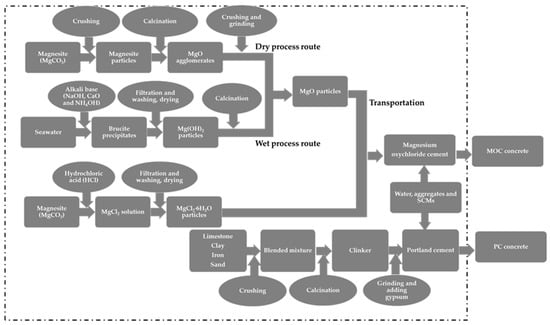 Figure 2. System boundary used for the LCA of MOC samples prepared with various molar ratios of MgO/MgCl2∙6H2O and sources of reactive MgO and PC samples.
Figure 2. System boundary used for the LCA of MOC samples prepared with various molar ratios of MgO/MgCl2∙6H2O and sources of reactive MgO and PC samples. - Impact assessment: In this LCA study, Eco-indicator 99 was employed as it facilitates the selection of a series of environmental indicators to acquire the environmental loads associated with the production of various binders quantitatively, reflected by several categories. Several key categories such as climate change, affected by CO2 emissions, were also incorporated in this method, and these categories provided a comprehensive profile of the ecological impacts of MOC and PC sample preparation. Meanwhile, these categories also gave a clear representation of the impacts related to human health, ecosystem quality and resources [,,]. Furthermore, the sum of various scores associated with a series of environmental impacts into a single score facilitates a useful comparison of various products and processes, and the weighting and interpretation procedures of environmental burdens used in Eco-indicator 99 [] are also shown in Figure 3. Meanwhile, a mixing triangle was employed to tackle the weighting issues for the two products/processes, in which the indifference curves were calculated by the determination of the points where they cross the boundaries of the triangle []. Furthermore, the global warming potential (GWP) of MOC and PC samples was also investigated by IPCC 2007 within a timeframe of 100 years.
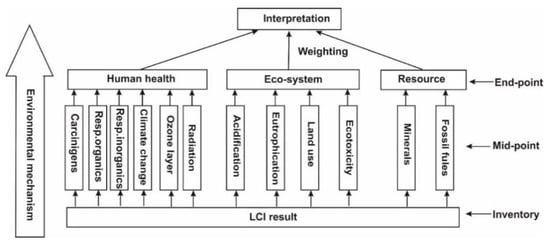 Figure 3. Weighting and interpretation of environmental burdens used in Eco-indicator 99 [].
Figure 3. Weighting and interpretation of environmental burdens used in Eco-indicator 99 []. - Description of allocation: Allocation is of great importance, as sometimes a production process may produce more than one end-product. In this study, during the synthesis of Mg(OH)2 from seawater, which is the main product, some by-products also formed simultaneously, such as NaCl. Therefore, the environmental burdens have to be divided between these two final products in a way that reflects the underlying relationships between them, e.g., allocation by mass or by economic value []. Figure 4 shows the illustration of allocation in this study. The mass allocation coefficient CM and economical allocation coefficient CE can be calculated as the mass and economical value ratio between main product and by-product, respectively, shown in Equations (3)–(4):CM = Mmain product/(Mmain product + Mby-product)CE = Emain product/(Emain product + Eby-product).
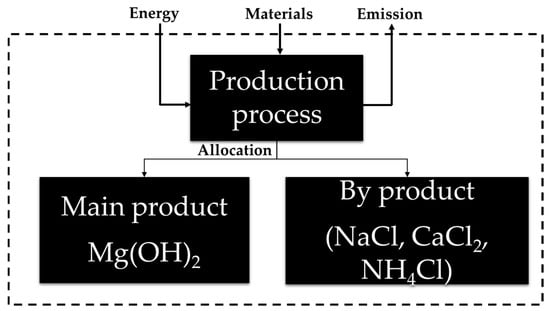 Figure 4. Illustration of allocation procedures in this study.
Figure 4. Illustration of allocation procedures in this study.
In view of this, the selection of an allocation procedure will greatly influence the outcomes of a study, which has proven to be one of the most controversial issues in LCA studies []. However, it is also suggested that the influence of different allocation procedures on the results should be investigated when performing LCA [].
3. Results
3.1. Environmental Assessment of MOC Paste Prepared with Various Molar Ratios of MgO/MgCl2∙6H2O
The individual impact category for 1.0 kg of MOC prepared with various MgO/MgCl2 ratios is presented in Figure 5. With the increase in the molar ratio of MOC samples, the score of every impact category increases linearly, and the single score of MOC-3 is 10.4% lower than that of MOC-5, indicating its higher sustainability. The results indicate that the production of MgCl2∙6H2O presented lower environmental impacts, which is in line with [], by contrast with that associated with the synthesis of MgO from seawater, which could be related to the different amounts of HCl (i.e., 0.36 kg) and NaOH (i.e., 2 kg) used in the production of 1.0 kg of MgCl2∙6H2O and Mg(OH)2, respectively. With regard to the preparation of all three types of MOC paste, respiratory organics present the lowest score due to the low organic particulate emissions associated with MOC paste preparation, whereas the representation clearly identifies fossil fuels as the largest impact category when preparing all three types of MOC paste since the production of NaOH and HCl involves the process of salt or brine electrolysis, which presents a relatively low energy efficiency, as indicated by the ETU-ESU database, leading to massive fossil fuel consumption during their production phases. Figure 6 shows the environmental impacts of 1.0 kg MOC paste preparation in terms of different damage categories. As expected, the preparation of MOC-3 presents an advantage in terms of alleviating damage to human health, ecosystem quality and resources in comparison with the preparation of MOC-5 and MOC-9. Meanwhile, the damage to resources was more severe than the other two categories, which is also related to the large consumption of fossil fuels in the preparation of MOC samples, as explained before.
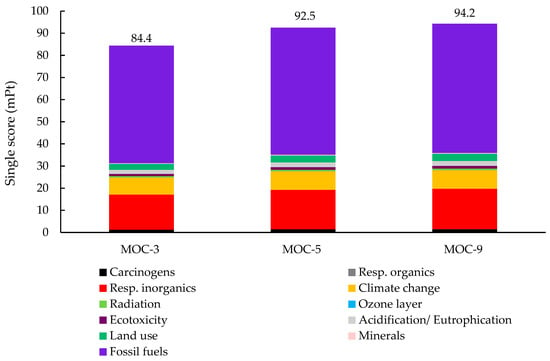
Figure 5.
Environmental impacts of 1.0 kg MOC prepared by various MgO/MgCl2 ratios (alkali base used during the synthesis of MgO: NaOH) in terms of different impact categories).
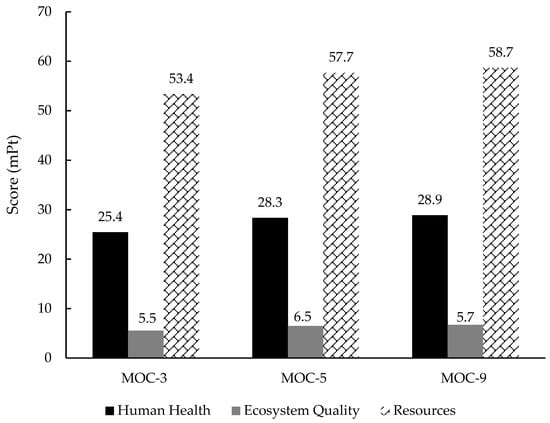
Figure 6.
Environmental impacts of 1.0 kg MOC preparation (alkali base used during the synthesis of MgO: NaOH) in terms of different damage categories.
3.1.1. CO2 Sequestration Potential of MOC Paste Prepared with Various Molar Ratios of MgO/MgCl2∙6H2O
In addition to the formation of some hydration phases such as phase-5 and phase-3 crystals, the presence of chlorartinite (Mg2(CO3)Cl(OH)∙3H2O) and hydromagnesite (Mg5(CO3)4(OH)2·4H2O) was also found in in MOC samples as the major Mg-carbonates, indicating that the hydrated magnesium-bearing phases are susceptible to carbonation []. During carbonation, an alkaline environment, the leaching of Mg2+ and the presence of CO32− ions in solutions are the prerequisites for the formation of magnesium-bearing carbonates [], allowing for carbonation to occur in the interfacial water layers on the surfaces of MOC samples []. With respect to the sources of ions involved during the carbonation, the CO32− ions are derived from atmospheric CO2, though the concentration is quite low (i.e., 0.04%). Regarding the Mg2+ ion sources, there are two main ones: (1) from the dissolution of phase-3 or phase-5 crystals or (2) from the dissolution of brucite in the interfacial water layers. The dissolution of phase-3 or phase-5 crystals and brucite also provides a high-pH environment as well as Cl− ions. The chemical reactions in terms of the carbonation of MOC samples are shown in Equations (5)–(10):
5Mg(OH)2∙MgCl2∙8H2O → 6Mg2+ + 10OH− + 2Cl− + 9H2O
3Mg(OH)2∙MgCl2∙8H2O → 4Mg2+ + 6OH− + 2Cl− + 9H2O
Mg(OH)2 → Mg2+ + 2OH−
CO2 + H2O ↔ H2CO3 ↔ 2H+ + CO32−
2Mg2+ + CO32− + OH− + Cl− + 3H2O → Mg2(CO3)Cl(OH)∙3H2O
5Mg2+ + 4CO32− + 2OH− + 3H2O → Mg5(CO3)4(OH)2 · 4H2O.
Various stages with respect to the carbonation of MOC samples are shown in Figure 7. It was reported that hydromagnesite formed after the formation of chlorartinite []. In theory, the completion of the precipitation of chlorartinite would consume all the Cl− ions and a proportion of the Mg2+ ions in the interfacial layer, leaving the remaining Mg2+ ions in the layer to be involved in the later formation of hydromagnesite. The calculated results of CO2-eq sequestration potential of 1.0 kg MOC preparation are shown in Figure 8. The figure shows that MOC samples with a greater molar ratio present a greater sequestration potential of CO2. For instance, the CO2 absorption capacity of MOC-9 is 57.7% higher than that of MOC-3, which could be ascribed to the different sequestration capacities of CO2 shown by MgO (i.e., 1.1 kg CO2/kg MgO) and MgCl2∙6H2O (i.e., 0.22 kg CO2/kg MgCl2∙6H2O), leading to a higher CO2 absorption capacity in MOC samples with greater molar ratios of MgO/MgCl2∙6H2O. The CO2 re-absorbed by MOC samples offset the CO2 emissions associated with their preparation.

Figure 7.
Illustration of various stages with respect to the carbonation of MOC samples [].
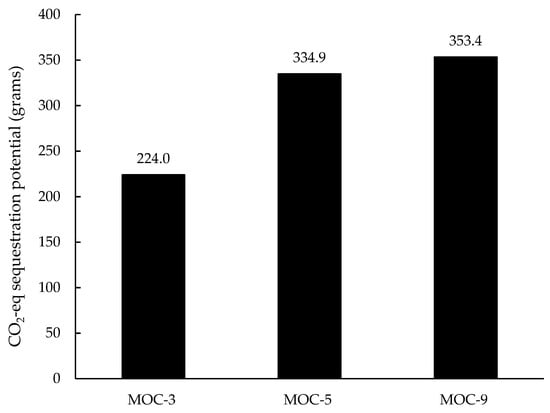
Figure 8.
CO2-eq sequestration potential of 1.0 kg MOC sample preparation (alkali base used during the synthesis of MgO: NaOH).
3.1.2. CO2 Intensities of MOC Paste Prepared with Various Molar Ratios of MgO/MgCl2∙6H2O
The use of a unit of volume or mass as a functional unit of sample formulations is often not practical or comprehensive enough since the mechanical performances of sample formulations such as compressive and flexural strength are a more accurate reflection of the major function of samples in a majority of constructions instead of volume or mass []. Therefore, the eco-efficiency indicator is proposed as it can be expressed with respect to the environmental burden caused by delivering one unit of functional performance (i.e., compressive and flexural strength) in MOC samples in this study. The use of a performance indicator as a functional unit facilitates the elimination of the distinction between a material scale (e.g., kg or m3), and a structural scale, allowing for a fair comparison between the efficiency of mixtures with different performances, which facilitates the search for an optimal molar ratio of MgO/MgCl2∙6H2O in turn. As a result, the use of functional performance should be adopted instead of a functional unit (e.g., m3) or mass (e.g., tonne) in the environmental assessment []. Under this study, the calculation of CO2-eq intensities was proposed to investigate the global warming potential (GWP) in Equation (11), enabling a more comprehensive comparison of eco-efficiency of MOC samples prepared with various molar ratios of MgO/MgCl2∙6H2O:
where Cd is the total CO2-eq emissions (kg) and f is the seven-day compressive or flexural strength (MPa) of each MOC sample. As mentioned before, the strength development of MOC samples is very fast [], as seen in Table 6, so seven-day strength of MOC paste is sufficient for its usage in practice, meeting the strength requirements of most applications.
Ci = Cd/f,

Table 6.
The quantity of each component used to produce 1 kg of MOC sample (details and the standard deviations can be found in our previous study []).
According to Equation (11), when the binders emit similar CO2 emissions, a mixture with greater strength would show lower CO2 intensity, and improving the mechanical properties of samples would definitely lead to the higher eco-efficiency of samples (i.e., a lower CO2-eq intensity) in this study, leading to the production of a ‘green binder’ []. The CO2-eq intensities for the preparation of 1.0 kg MOC paste with different molar ratios of MgO/MgCl2∙6H2O are presented in Figure 9. Our previous study [] indicated that with the increase of the MgO/MgCl2 molar ratio, the flexural strength of MOC samples reduced due to the formation of a larger number of microcracks on the surface of MOC samples. Meanwhile, a larger MgO/MgCl2 molar ratio in MOC samples led to greater compressive strength, which was associated with a higher amount of phase-5 crystal (5Mg(OH)2∙MgCl2∙8H2O) formation, namely the main phase contributing to mechanical strength. Therefore, the representation indicated that the molar ratios of MOC samples should be reduced in terms of eco-efficiency (i.e., CO2-eq intensity) considering the flexural strength of MOC paste, whereas in terms of environmental efficiency, which takes compressive strength into account, as expected, the indicator of MOC-9 presents an advantage over the rest of the MOC samples, and a higher molar ratio should be adopted due to the lower CO2-eq intensity. Therefore, in view of the CO2-eq intensities, the molar ratios should be selected carefully depending on the strength requirement of the applications.
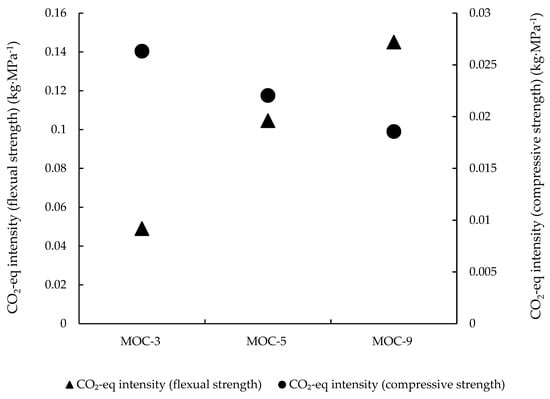
Figure 9.
CO2-eq intensity of 1.0 kg MOC preparation (alkali base used during the synthesis of MgO: NaOH).
3.2. Environmental Assessment of MOC Paste Prepared with MgO Synthesized by Various Alkali Bases
The type of alkali base used during the precipitation of Mg(OH)2 from seawater greatly affects the energy inputs []; however, previous studies [,] failed to provide the outputs associated with the production process of synthetic MgO. Moreover, during the precipitation of Mg(OH)2 (i.e., main product) from seawater, several by-products are also produced simultaneously, so the environmental burdens have to be divided between them in a way that indicates the underlying relationships between them [].
As indicated in Section 2.2.2, three types of commonly used alkali bases were chosen, i.e., CaO, NaOH and NH4OH, and they generated the by-products of NaCl, CaCl2 and NH4Cl, respectively, as a result of this process, as illustrated in Equations (12)–(15). Furthermore, two types of widely used allocation procedures, namely allocation by mass or by economic value, were applied during this production process to show the different scenarios in this study. In this part, the mix composition of MOC-9 was selected:
2NaOH + MgCl2 → Mg(OH)2 + NaCl
CaO + H2O + MgCl2 → Mg(OH)2 + CaCl2
NH4OH + MgCl2 → Mg(OH)2 + NH4Cl
Mg(OH)2 → MgO + H2O.
Figure 10 shows the (a) single scores and (b) CO2-eq emissions of 1.0 kg of MOC-9 prepared with MgO synthesized by the use of alkali bases including CaO, NaOH and NH4OH. The use of CaO as the alkali base presented an advantage over the use of NaOH and NH4OH during the precipitation of Mg(OH)2 from seawater in terms of the overall environmental impacts, reflected by the single score, whereas the adoption of NH4OH posed the largest burdens to the environment. This is interpreted by the fact that the production of NH4OH has a higher energy demand (i.e., pressure (i.e., 200 atm)) and involves the use of some catalysts (e.g., iron), leading to more severe overall environmental impacts in contrast with the production of CaO, which is obtained from the calcination of limestone (i.e., a type of natural mineral) at a temperature of around 850 °C, shown in Equation (16), thus causing less damage to the environment. In terms of CO2-eq emissions, the use of CaO led to a slightly higher global warming potential than NaOH, which could be ascribed to the large CO2 emissions during the calcination of limestone (CaCO3) (Equation (16)), leading to a larger GWP related to sample preparation:
CaCO3 → CaO + CO2.
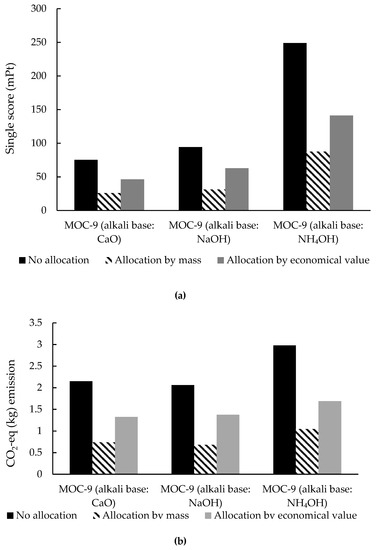
Figure 10.
Single score (a) and CO2-eq emission (b) of 1.0 kg MOC-9 prepared with MgO synthesized by various alkali bases. The results were allocated by mass and economical value allocation.
Table 7 shows the percentages of allocation by mass and economic value for Mg(OH)2, CaCl2, NaCl and NH4Cl. As can be seen from the table, percentages of allocation by mass were much lower compared with allocation by economic value in terms of the main product, and the percentages of allocation by mass are quite close, ranging from 33.1% to 35.1%. However, a large variance concerning the percentages of allocation by economic value (i.e., 56.7–66.7%) is observed. As a result, the single scores and CO2-eq emissions using allocation by mass were much smaller in comparison with those involving the use of allocation by economic value. Meanwhile, the use of CaO as the alkali base still outperformed the use of NaOH and NH4OH during the precipitation of Mg(OH)2 irrespective of the allocation methods, as shown in Figure 9.

Table 7.
Percentages of allocation by mass and economic value used for Mg(OH)2 and CaCl2 NaCl and NH4Cl. Individual mass and market prices are shown to justify the results.
3.3. Comparative Environmental Assessment of MOC Concrete Prepared with Different MgO Sources and PC Concrete
3.3.1. Contribution Analysis and CO2-eq Emissions
Figure 11 presents the contribution analysis of each environmental impact associated with 1 kg MOC concrete prepared by (a) MgO from the dry process route or (b) the wet process route; and (c) PC concrete. The contributions of climate change (the orange area), related to CO2 emissions, vary greatly among different concrete sample preparations. The score of climate change is 21.2% of the overall single score in MOC concrete made by MgO from the dry process route (Figure 11a), a value much higher than that of the other two groups (Figure 11b,c), which can be ascribed to the decomposition of magnesite (Equation (1)) and its emission of a large amount of CO2 (1.1 kg CO2/kg MgO) during this process. Meanwhile, as the calcination temperature of PC is very high (i.e., 1450 °C) and the production of alkali bases in synthetic MgO is an energy-intensive process, the scores of fossil fuels in MOC concrete prepared by MgO from the wet process route and PC concrete are 65.2% (Figure 11b) and 72.5% (Figure 11c) of the total single score, respectively, which is much higher than MOC concrete when the MgO is obtained via the dry process route (Figure 11a). Figure 12 reveals the CO2-eq emissions of 1.0 kg MOC concrete prepared by MgO obtained from the dry and wet process routes, and PC concrete. As expected, the CO2-eq of 1 kg MOC concrete prepared by MgO from the dry and wet process routes is 35.0% and 25.0% higher than that emitted by the PC concrete preparation, indicating that, in contrast with PC concrete, MOC concrete cannot be categorized as a ‘low-carbon’ binder.
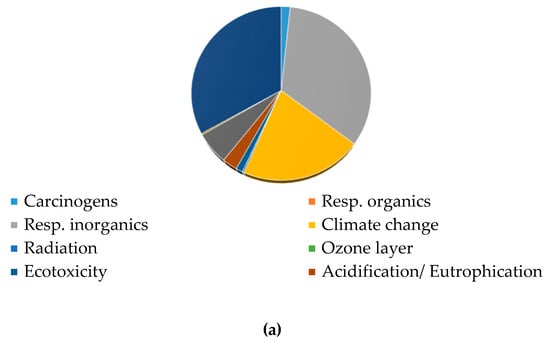
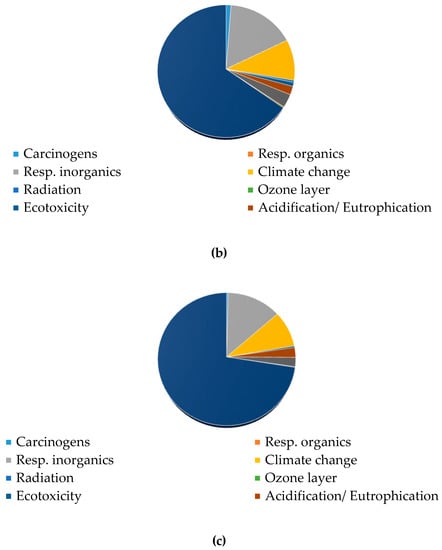
Figure 11.
Contribution analysis of each environmental impact associated with (a) 1 kg MOC concrete prepared by MgO from the dry process route (calcination of magnesite), (b) 1 kg MOC concrete prepared by MgO from the wet process route (synthesized from seawater; alkali base: CaO; allocation: by mass; Molar ratio: 9), and (c) 1 kg PC concrete.
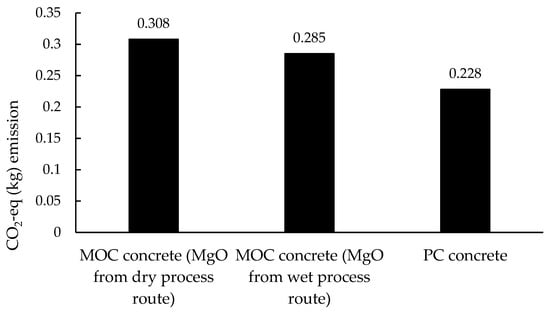
Figure 12.
CO2-eq emissions of 1.0 kg MOC concrete prepared by MgO obtained from the dry process route (calcination of magnesite) and the wet process route (synthesized from seawater; alkali base: CaO; allocation: by mass; Molar ratio: 9), and 1.0 kg PC concrete.
3.3.2. Single Score and Weighting Process
Figure 13a presents a comparison of the single score for 1.0 kg of MOC concrete prepared by MgO obtained from the dry process route (i.e., calcination of magnesite) and the wet process route (i.e., synthesized from seawater; allocation by mass; alkali base: CaO), and 1.0 kg PC concrete. The figure shows that MOC concrete prepared by MgO obtained from the dry process route outperformed the PC sample in terms of the overall environmental impacts, reflected by a 45.2% lower single score. Also, it is interesting to find that the preparation of PC concrete is more eco-friendly than MOC concrete prepared by MgO obtained from the wet process route. Meanwhile, the preparation of PC concrete led to more severe damage to resources than MOC concrete prepared by MgO obtained from the dry process route, as also seen in Figure 13a, which could be ascribed to the fact that the preparation of PC samples involves the use of multiple raw materials including limestone, sand, clay, iron and gypsum, whereas the preparation of MOC concrete only requires the utilization of magnesite in the dry process route, as seen in Equations (1) and (2). Furthermore, two mixing triangles were used to assess the overall environmental impacts of each type of concrete on human health, ecosystem quality and resources, improving the clarity of the weighting process via addressing the weighting issues more efficiently than the single score method, thus facilitating better decision-making. The mixing triangles are shown in Figure 13b, and the figures indicated the same findings as mentioned before, where only MOC concrete prepared by MgO from the dry process route can be categorized as a more sustainable binder than PC. Meanwhile, as indicated before, MOC concrete presents a rapid strength development [], so, compared with the strength of PC concrete [] after seven days, the authors believe that MOC concrete revealed higher strength within the same curing age, which led to lower CO2-eq intensities in comparison with those related to the preparation of PC concrete.
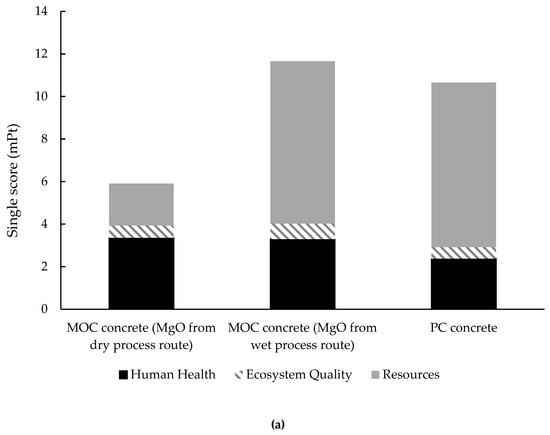
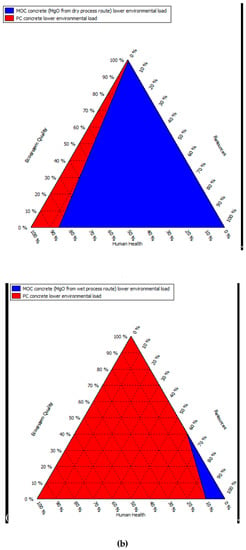
Figure 13.
Comparison of (a) single score and (b) mixing triangle of environmental impacts of 1.0 kg MOC concrete prepared by MgO obtained from the dry process route (calcination of magnesite) and the wet process route (synthesized from seawater; alkali base: CaO; allocation: by mass; molar ratio: 9), and 1.0 kg PC concrete.
4. Discussion
The majority of magnesite deposits and magnesia production (i.e., the key component in MOC production) are based in China [], which reduces the convenience of the magnesia requirement from the calcination of magnesite in Europe and keeps the price of magnesia higher than that of PC. Meanwhile, the transportation of magnesia from China to Europe puts further stress on the environment. In Europe, Austria, Slovakia, Greece and Spain have some magnesite deposits, but their annual output of magnesia is far less than the amount of magnesia imported from China. In view of this, a sensitivity analysis is necessary since the majority of magnesia is from China, and the travel distances of reactive magnesia from Liaoning Province (which is the major province for MgO production in China) to Europe was assumed to be 7000–9000 km, separately by freighter. From Figure 14, it is clear that the shipping of reactive magnesia from China to Europe has a negligible influence on the single scores and CO2 emissions associated with the preparation of MOC concrete when MgO is obtained from the dry process route.
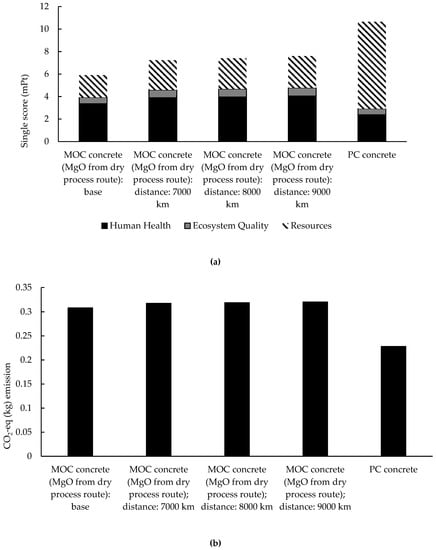
Figure 14.
Sensitivity analysis in terms of the influence of various transportation distances on the (a) single scores and (b) CO2-eq emissions associated with MOC concrete from the dry and wet process routes (base: transportation is not considered in the MOC concrete preparation).
In addition to magnesite, some alternative magnesium-bearing minerals such as magnesium silicate (talc) or dolomite could also be ideal precursors for the production of magnesia, as they are abundant worldwide and can be extracted easily, similar to the calcination of magnesite, thereby increasing the supply and reducing the current price of MgO from magnesite in Europe.
5. Conclusions
- Increasing the molar ratios in MOC paste led to more severe environmental impacts and greater CO2 sequestration potentials, which are related to the difference between MgO and MgCl2∙6H2O in terms of their energy requirements for production and their CO2 binding capacities.
- In terms of environmental efficiency, as reflected by CO2 intensities, the molar ratios of MOC paste should be carefully selected depending on the strength requirements of the applications, and allocating the environmental impacts of MgO production by mass is more favourable.
- The transportation of reactive MgO from China to Europe has a negligible influence on the environmental impacts of MOC concrete preparation when MgO is from the dry process route, and MOC concrete cannot be categorized as a type of ‘low-carbon’ binder, by contrast with PC concrete. Meanwhile, in terms of the overall environmental impacts, MOC concrete can only be recognized as a more sustainable binder than PC concrete when the main component, MgO, is obtained through the dry process route rather than the wet process route in MOC concrete preparation.
Author Contributions
G.K. and S.L. studied the mechanical performance of samples. S.R. and C.U. designed the process and performed the LCA studies. X.Z. is the project leader and revised the final manuscript.
Funding
This research was funded by the European Commission Horizon 2020 Research and Innovation Programme through the grant 723825 (i.e., the Green INSTRUCT project).
Acknowledgments
The authors would like to acknowledge the lab technician, Neil Macfadyen, for his assistance.
Conflicts of Interest
The authors declare no conflict of interest.
References
- Altiner, M.; Yildirim, M. Study of using dolomite as starting material resource to produce magnesium oxychloride cement. J. Adv. Concr. Technol. 2017, 15, 269–277. [Google Scholar] [CrossRef][Green Version]
- Góchez, R.R.; Vreeland, T.; Wambaugh, J.; Kitchens, C.L. Conversion of magnesium oxychloride to chlorartinite and resulting increased water resistance. Mater. Lett. 2017, 207, 1–3. [Google Scholar] [CrossRef]
- Xu, B.; Ma, H.; Hu, C.; Yang, S.; Li, Z. Influence of curing regimes on mechanical properties of magnesium oxychloride cement-based composites. Constr. Build. Mater. 2016, 102, 613–619. [Google Scholar] [CrossRef]
- Tang, S.; Hu, Y.; Ren, W.; Yu, P.; Huang, Q.; Qi, X.; Li, Y.; Chen, E. Modeling on the hydration and leaching of eco-friendly magnesium oxychloride cement paste at the micro-scale. Constr. Build. Mater. 2019, 204, 684–690. [Google Scholar] [CrossRef]
- Barnes, P.; Bensted, J. Structure and Performance of Cements; CRC Press: London, UK, 2002. [Google Scholar]
- Li, Z.; Chau, C. Influence of molar ratios on properties of magnesium oxychloride cement. Cem. Concr. Res. 2007, 37, 866–870. [Google Scholar] [CrossRef]
- Li, Y.; Yu, H.; Zheng, L.; Wen, J.; Wu, C.; Tan, Y. Compressive strength of fly ash magnesium oxychloride cement containing granite wastes. Constr. Build. Mater. 2013, 38, 1–7. [Google Scholar] [CrossRef]
- He, P.; Poon, C.S.; Tsang, D.C. Comparison of glass powder and pulverized fuel ash for improving the water resistance of magnesium oxychloride cement. Cem. Concr. Compos. 2018, 86, 98–109. [Google Scholar] [CrossRef]
- Zhang, R.; Panesar, D.K. Sulfate resistance of carbonated ternary mortar blends: Portland cement, reactive MgO and supplementary cementitious materials. J. Clean. Prod. 2019, 238. [Google Scholar] [CrossRef]
- Zhang, R.; Panesar, D.K. Design of carbonated r–MgO–PC binder system: effect of r–MgO replacement level and water–to–binder ratio. J. Am. Ceram. Soc. 2019. [Google Scholar] [CrossRef]
- Zhang, R.; Bassim, N.; Panesar, D.K. Characterization of Mg components in reactive MgO–Portland cement blends during hydration and carbonation. J. CO2. Util. 2018, 27, 518–527. [Google Scholar] [CrossRef]
- Wang, L.; Chen, L.; Cho, D.-W.; Tsang, D.C.; Yang, J.; Hou, D.; Baek, K.; Kua, H.W.; Poon, C.-S. Novel synergy of Si-rich minerals and reactive MgO for stabilisation/solidification of contaminated sediment. J. Hazard. Mater. 2019, 365, 695–706. [Google Scholar] [CrossRef] [PubMed]
- Wang, L.; Chen, L.; Tsang, D.C.; Kua, H.W.; Yang, J.; Ok, Y.S.; Ding, S.; Hou, D.; Poon, C.S. The roles of biochar as green admixture for sediment-based construction products. Cem. Concr. Compos. 2019. [Google Scholar] [CrossRef]
- Wang, L.; Iris, K.; Tsang, D.C.; Yu, K.; Li, S.; Poon, C.S.; Dai, J.-G. Upcycling wood waste into fibre-reinforced magnesium phosphate cement particleboards. Constr. Build. Mater. 2018, 159, 54–63. [Google Scholar] [CrossRef]
- Shand, M.A. The Chemistry and Technology of Magnesia; John Wiley and Sons: Hoboken, NJ, USA, 2006. [Google Scholar]
- Kramer, D.A. Magnesium, its Alloys and Compounds. Industrial Minerals and Rocks; U.S. Geological Survey: Reston, VA, USA, 2001; pp. 1258–2331. [Google Scholar]
- Jin, F.; Al-Tabbaa, A. Characterisation of different commercial reactive magnesia. Adv. Cem. Res. 2014, 26, 101–113. [Google Scholar] [CrossRef]
- Dong, H.; Unluer, C.; Yang, E.-H.; Al-Tabbaa, A. Synthesis of reactive MgO from reject brine via the addition of NH4OH. Hydrometallurgy 2017, 169, 165–172. [Google Scholar] [CrossRef]
- Hassan, D. Environmental Sustainability Assessment and Associated Experimental Investigations of Magnesia Production Routes; University of Cambridge: Cambridge, UK, 2014. [Google Scholar]
- Dong, H.; Yang, E.-H.; Unluer, C.; Jin, F.; Al-Tabbaa, A. Investigation of the properties of MgO recovered from reject brine obtained from desalination plants. J. Clean. Prod. 2018, 196, 100–108. [Google Scholar] [CrossRef]
- Anthony, J.W.; Bideaux, R.A.; Bladh, K.W.; Nichols, M.C. Handbook of Mineralogy, Mineralogical Society of America; Mineral Data Publishing: Chantilly, VA, USA, 2003. [Google Scholar]
- CFR. Code of Federal Regulations Title 21; Food and Drug Administration: Washington, DC, USA, 2018. [Google Scholar]
- Sinka, M.; Van den Heede, P.; De Belie, N.; Bajare, D.; Sahmenko, G.; Korjakins, A. Comparative life cycle assessment of magnesium binders as an alternative for hemp concrete. Resour. Conserv. Recy. 2018, 133, 288–299. [Google Scholar] [CrossRef]
- Al-Breiki, M.; Bicer, Y. Thermodynamic analysis of theoretical dolomite formation from seawater and captured carbon dioxide. SN Appl. Sci. 2019, 1, 1272. [Google Scholar] [CrossRef]
- Ruan, S.; Unluer, C. Effect of air entrainment on the performance of reactive MgO and PC mixes. Constr. Build. Mater. 2017, 142, 221–232. [Google Scholar] [CrossRef]
- Ruan, S.; Liu, J.; Yang, E.-H.; Unluer, C. Performance and microstructure of calcined dolomite and reactive magnesia-based concrete samples. J. Mater. Civ. Eng. 2017, 29. [Google Scholar] [CrossRef]
- Ruan, S.; Unluer, C. Influence of supplementary cementitious materials on the performance and environmental impacts of reactive magnesia cement concrete. J. Clean. Prod. 2017, 159, 62–73. [Google Scholar] [CrossRef]
- Ruan, S.; Unluer, C. Influence of mix design on the carbonation, mechanical properties and microstructure of reactive MgO cement-based concrete. Cem. Concr. Compos. 2017, 80, 104–114. [Google Scholar] [CrossRef]
- He, P.; Poon, C.S.; Tsang, D.C. Effect of pulverized fuel ash and CO2 curing on the water resistance of magnesium oxychloride cement (MOC). Cem. Concr. Res. 2017, 97, 115–122. [Google Scholar] [CrossRef]
- Power, I.M.; Dipple, G.M.; Francis, P.S. Assessing the carbon sequestration potential of magnesium oxychloride cement building materials. Cem. Concr. Compos. 2017, 78, 97–107. [Google Scholar] [CrossRef]
- Dong, H.; Unluer, C.; Yang, E.-H.; Al-Tabbaa, A. Recovery of reactive MgO from reject brine via the addition of NaOH. Desalination 2018, 429, 88–95. [Google Scholar] [CrossRef]
- Li, Y.; Yu, H.; Dong, J.; Wen, J.; Tan, Y. Reseach development on hydration product, phase transformation and water resistance evaluation method of magnesium oxychloride cement. J. Chin. Ceram. Soc. 2013, 41, 1465–1473. [Google Scholar]
- He, P.; Hossain, M.U.; Poon, C.S.; Tsang, D.C. Mechanical, durability and environmental aspects of magnesium oxychloride cement boards incorporating waste wood. J. Clean. Prod. 2019, 207, 391–399. [Google Scholar] [CrossRef]
- Wei, L.; Wang, Y.; Yu, J.; Xiao, J.; Xu, S. Feasibility study of strain hardening magnesium oxychloride cement-based composites. Constr. Build. Mater. 2018, 165, 750–760. [Google Scholar] [CrossRef]
- Finkbeiner, M.; Inaba, A.; Tan, R.; Christiansen, K.; Klüppel, H.-J. The new international standards for life cycle assessment: ISO 14040 and ISO 14044. Int. J. Life Cycle Assess. 2006, 11, 80–85. [Google Scholar] [CrossRef]
- Alejandre, F.; Flores-Ales, V.; Villegas, R.; Garcia-Heras, J.; Moron, E. Estimation of Portland cement mortar compressive strength using microcores. Influence of shape and size. Constr. Build. Mater. 2014, 55, 359–364. [Google Scholar] [CrossRef]
- Li, Z.J.; Qiao, F.; Chau, C.K. Recent Development of Magnesium-Based Cements-Magnesium Phosphate Cement and Magnesium Oxychloride Cement. Adv. Sci. Tech. 2010, 69, 21–30. [Google Scholar] [CrossRef]
- Ecoinvent. The Life Cycle Inventory Data; Swiss Centre for Life Cycle Inventories: Duebendorf, Switzerland, 2014. [Google Scholar]
- ETH-ESU. Ökoinventare von Energiesystemen; ETH Technical University of Zürich: Zurich, Switzerland, 1996. [Google Scholar]
- Ruan, S.; Unluer, C. Comparative life cycle assessment of reactive MgO and Portland cement production. J. Clean. Prod. 2016, 137, 258–273. [Google Scholar] [CrossRef]
- Li, J.; Zhang, Y.; Shao, S.; Zhang, S. Comparative life cycle assessment of conventional and new fused magnesia production. J. Clean. Prod. 2015, 91, 170–179. [Google Scholar] [CrossRef]
- Spielmann, M.; Bauer, C.; Dones, R.; Tuchschmid, M. Life Cycle Inventories of Transport Services. Int. J. Life Cycle Assess. 2005, 10, 10–94. [Google Scholar] [CrossRef]
- Kellenberger, D.; Althaus, H.-J.; Jungbluth, N.; Künniger, T.; Lehmann, M.; Thalmann, P. Life Cycle Inventories of Building Products; Swiss Centre for Life Cycle Inventories: Duebendorf, Switzerland, 2007. [Google Scholar]
- Josa, A.; Aguado, A.; Heino, A.; Byars, E.; Cardim, A. Comparative analysis of available life cycle inventories of cement in the EU. Cem. Concr. Res. 2004, 34, 1313–1320. [Google Scholar] [CrossRef]
- ATILH. Methodology for Yearly Declaration of Pollutant Emissions in French Cement Industry; Hydraulic binder Industries Union; Association Technique des Liants Hydrauliques: Paris, France, 2003. (In French) [Google Scholar]
- Boesch, M.E.; Hellweg, S. Identifying improvement potentials in cement production with life cycle assessment. Environ. Sci. Technol. 2010, 44, 9143–9149. [Google Scholar] [CrossRef]
- Chen, C.; Habert, G.; Bouzidi, Y.; Jullien, A.; Ventura, A. LCA allocation procedure used as an incitative method for waste recycling: An application to mineral additions in concrete. Resour.Conserv. Recy. 2010, 54, 1231–1240. [Google Scholar] [CrossRef]
- Guardigli, L.; Monari, F.; Bragadin, M.A. Assessing environmental impact of green buildings through LCA methods: Acomparison between reinforced concrete and wood structures in the European context. Proc. Eng. 2011, 21, 1199–1206. [Google Scholar] [CrossRef]
- Ruan, S.; Unluer, C. Comparison of the environmental impacts of reactive magnesia and calcined dolomite and their performance under different curing conditions. J. Mater. Civ. Eng. 2018, 30. [Google Scholar] [CrossRef]
- Goedkoop, M.; Schryver, A.; Oele, M.; Durksz, S.; de Roest, D. Introduction to LCA with SimaPro 7; Pré Consultants: Amsterdam, The Netherlands, 2010. [Google Scholar]
- Hofstetter, P.; Braunschweig, A.; Mettier, T.; Müller-Wenk, R.; Tietje, O. The mixing triangle: Correlation and graphical decision support for LCA–based comparisons. J. Ind. Ecol. 1999, 3, 97–115. [Google Scholar] [CrossRef]
- Sayagh, S.; Ventura, A.; Hoang, T.; Francois, D.; Jullien, A.S. Sensitivity of the LCA allocation procedure for BFS recycled into pavement structures. Resour. Conserv. Recy. 2010, 54, 348–358. [Google Scholar] [CrossRef]
- Sugimoto, K.; Dinnebier, R.E.; Schlecht, T. Structure determination of Mg3 (OH) 5Cl4·H2O (F5 phase) from laboratory powder diffraction data and its impact on the analysis of problematic magnesia floors. Acta Crystallogr. Sect. B Struct. Sci. 2007, 63, 805–811. [Google Scholar] [CrossRef] [PubMed]
- Damineli, B.L.; Kemeid, F.M.; Aguiar, P.S.; John, V.M. Measuring the eco-efficiency of cement use. Cem. Concr. Compos. 2010, 32, 555–562. [Google Scholar] [CrossRef]
- Kastiukas, G.; Zhou, X.; Neyazi, B.; Wan, K.T. Sustainable Calcination of Magnesium Hydroxide for Magnesium Oxychloride Cement Production. J. Mater. Civ. Eng. 2019, 31. [Google Scholar] [CrossRef]
- Damtoft, J.S.; Lukasik, J.; Herfort, D.; Sorrentino, D.; Gartner, E.M. Sustainable development and climate change initiatives. Cem. Concr. Res. 2008, 38, 115–127. [Google Scholar] [CrossRef]
- Kim, J.-K.; Moon, Y.-H.; Eo, S.-H. Compressive strength development of concrete with different curing time and temperature. Cem. Concr. Res. 1998, 28, 1761–1773. [Google Scholar] [CrossRef]
© 2019 by the authors. Licensee MDPI, Basel, Switzerland. This article is an open access article distributed under the terms and conditions of the Creative Commons Attribution (CC BY) license (http://creativecommons.org/licenses/by/4.0/).